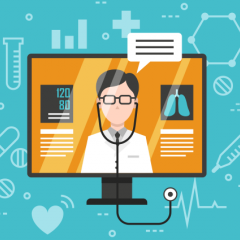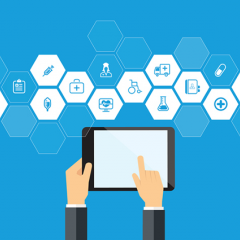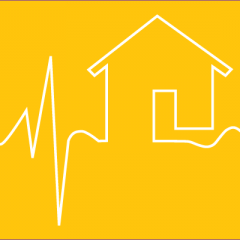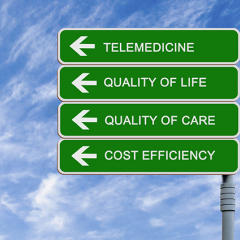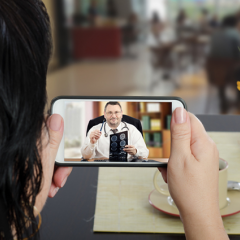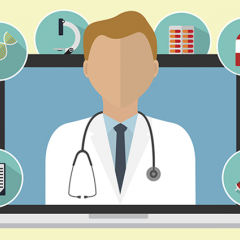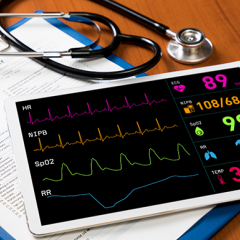How Mayo, Geisinger, IU Health Train Their At-Home Care Providers
mHealthIntelligence At-home care programs have proliferated across the country in recent years, primarily driven by the regulatory flexibilities and the in-person care constraints that resulted from the COVID-19 pandemic. Deploying these programs require providers to revamp various aspects of their operations, including staff training. The ongoing shift to care outside the hospital received a massive boost...
More Features
Telehealth Snapshot: Use Cases, Policies & Hybrid Care
As the COVID-19 pandemic hit, telehealth use skyrocketed, helping providers deliver quality healthcare when in-person services stalled. Though telehealth use has leveled off over the past year, providers and payers see the modality as a key...
How Providers Can Optimize Telehealth Workflows and Improve Experience
The COVID-19 pandemic is directly responsible for the dramatic rise of telehealth. But as providers quickly established new or expanded existing virtual care programs, they may not have addressed certain workflow hurdles and human factors...
How a Not-So-New Concept Buoyed Mayo, Advocate Aurora Amid a Crisis
Virtual care has helped health systems solve a myriad of problems during surges of the COVID-19 pandemic. Not only did digital healthcare help organizations care for patients outside their hospitals, but it also helped enhance critical care...
Incorporating a Human Element Into RPM Services
Over the past two years, remote patient monitoring (RPM) programs have increased, with health systems using the care modality for various clinical activities, including tracking chronic disease patient outcomes. Both providers and patients...
Using Hospital-At-Home Services to Lower Readmissions, Increase Capacity
As the Omicron variant drove COVID-19 case counts up, hospitals found themselves facing a familiar problem: caring for patients as inpatient capacity grew slim. Many health facilities relied on systems set up during earlier stages of the...
Using Data Analytics to Enhance Telehealth Services
With telehealth becoming increasingly integrated into care delivery at provider organizations across the country, some are going one step further and optimizing it. For Children's National, a health system based in Washington, D.C.,...
Key Elements of Top Mobile Patient Portal Apps
With the advent of online retail and e-banking, consumers have become accustomed to using their computers and phones to perform a wide range of tasks. This increase in mobile use provided two critical opportunities for healthcare: improve...
Keeping Health Equity Top-of-Mind in Remote Patient Monitoring Programs
Interest in home-based care is on the rise, spurred by the COVID-19 pandemic that resulted in health facilities becoming overwhelmed and struggling to ensure ongoing access to care. A key aspect of home-based care is remote patient...
How Digital Therapeutics Will Evolve in 2022 and Beyond
As healthcare delivery has gone virtual, so have the clinical treatments themselves, resulting in a new category of medical interventions: digital therapeutics. Digital therapeutics are evidence-based, clinically evaluated software and...
RPM 101: What Is Remote Patient Monitoring, Its Benefits, and Uses?
Remote patient monitoring (RPM) though by no means a new care modality is evolving rapidly, spurred by the constraints of the COVID-19 pandemic and the corresponding regulatory push to expand access to care. In its simplest form, RPM...
How FQHCs Are Standing Up, Sustaining Remote Patient Monitoring Programs
Remote patient monitoring is growing in popularity in the U.S., especially since the COVID-19 pandemic restricted access to inpatient care. For many large health systems, the rising popularity of RPM has led them to expand or strengthen...
What 2022 Could Have in Store for Laws Governing Telehealth
Though telehealth usage has both dipped and grown at various points over the last year, it is expected to remain a key part of care delivery well beyond the COVID-19 pandemic. But its future depends on several factors, not least of which is...
Why Stanford Wants to Make CGM a Standard of Care for Diabetic Kids
With interest in remote patient monitoring skyrocketing, providers are exploring the various uses of this technology for different conditions. One arena where it could be a game-changer? Management of type 1 diabetes among children. In...
Using Telehealth to Treat SUD Has its Benefits, But Needs Improvements
When the COVID-19 pandemic hit, disrupting in-person care nationwide, those receiving treatment for substance use disorders (SUD) were suddenly cut off from life-saving services. Enter telehealth, which significantly expanded access to SUD...
How Telehealth Will Continue its Evolution Beyond Pandemic Response
It has been nearly two years since telehealth's meteoric rise in popularity. Though it is clear that telehealth is here to stay, its role in care delivery will continue to evolve beyond being a tool to address the social distancing...
How UPMC is Tackling Telehealth No-Shows, Missed Appointments
No-shows — that is, patients who do not show up for a scheduled appointment without informing the clinic beforehand — are a persistent problem in healthcare. Not only do no-shows result in lost revenue, but also waste...
How Abortion Providers Plan to Use Telehealth to Bolster Post-Roe Access
The fate of Roe v Wade — the landmark 1973 case that led to the legalization of abortion in America — appears to be in jeopardy, and as a result, abortion providers are preparing for a world where abortion access is severely...
Using Remote Patient Monitoring to Improve Quality Metrics, Experience
Interest in remote patient monitoring (RPM) is on the rise, and this interest is not limited to large, well-resourced health systems alone. Even smaller medical groups and rural private practices are taking advantage of this care modality....
As Telehealth Use Increased, Physicians’ Webside Manner Evolved
At the core of healthcare delivery is the provider-patient relationship. As telehealth grew in popularity over the past 18 months, providers had to establish and maintain this relationship virtually. Thus, physicians have had to adapt and...







